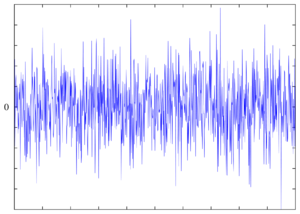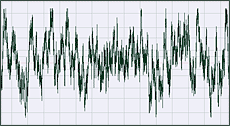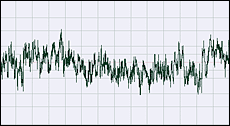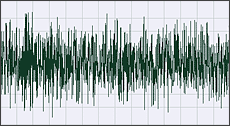
- Image via Wikipedia
Till date I didn’t had any idea about various colors of the noise . I used to consider that noise are of some basic types like shot noise, thermal noise, flicker noise. Basically these are the fundamental noise signal , But we have defined various colors to the noise. Noise has 10 different colors which have been defined and presented below.
This is very interesting to know that all these noise patterns are different but they are related to each other in some way or another. Thus it can be concluded that noise really has colors by definition as well as by pattern . you will discover this when you will scroll down and read the complete article . This classification of noise is sponsored by MEDIA COLLEGE.COM which helped in recognizing these noise patterns
Black Noise
Black noise has various definitions — as far as we are aware none of them are official. Some common definitions are listed below:
(1) Silence, no noise at all.
(2) Noise with a 1/f? spectrum, where ? > 2.
(3) Noise which has zero energy at most frequencies but contains occasional random spikes.
(4) The noise created by active noise control systems, designed to cancel existing noises.
(5) Ultrasonic white noise, i.e. white noise which is at a frequencies too high to hear but which can still affect the environment.
Blue Noise
Blue noise, AKA azure noise, is similar to pink noise except the power density increases 3 dB per octave as the frequency increases. In technical terms the density is proportional to f (frequency).
Brown Noise
 Brown noise is a random noise which mimics the signal noise produced by brownian motion. Technically speaking, the spectral density is proportional to 1/f2, which basically means it has more energy at lower frequencies (decreasing by around 6dB per octave).
Brown noise is a random noise which mimics the signal noise produced by brownian motion. Technically speaking, the spectral density is proportional to 1/f2, which basically means it has more energy at lower frequencies (decreasing by around 6dB per octave).
To the human ear, brown noise is similar to white noise but at a lower frequency. Examples in nature include waves on the beach and some wind noise.
Note: Some people use the term brown noise as a synonym for brown note, a controversial and unproven sound which causes the listener to lose control of their bowels.
Hear a 5-second example of brown noise (MP3, 119KB).
Gray Noise
Gray noise is a random noise which sounds the same at all frequencies to the human ear. This is not the same as white noise, which has the same energy at all frequencies. Rather, gray noise is subjected to a “psycho acoustic equal loudness curve” which compensates for the bias of the human ear so that it sounds the same at all frequencies.
Green Noise
Green noise is not an officially recognised term. There are several unofficial definitions in use — these appear to be the two most common:
(1) The mid-frequency component of white noise.
(2) “The background noise of the world”, a sort of new-age description of ambient noise averaged from several different outdoors locations. Similar in sound to pink noise with an emphasis on the range around 500Hz.
Orange Noise
The semi-official definition of orange noise is “a quasi-stationary noise with a finite power spectrum with a finite number of small bands of zero energy dispersed throughout a continuous spectrum.” We have not been able to determine where this definition originated but it is commonly used in reference material.
Orange noise relates to musical scales. The bands of zero energy coincide with the notes in the scale. In effect this means that the in-tune notes of a scale are removed, leaving only the out-of-tune frequencies. This creates a clashing, displeasing noise.
Pink Noise
 Pink noise (AKA 1/f noise or flicker noise) is similar to white noise except that it contains an equal amount of energy in each octave band. To put it technically, the power spectral density is proportional to the reciprocal of the frequency.
Pink noise (AKA 1/f noise or flicker noise) is similar to white noise except that it contains an equal amount of energy in each octave band. To put it technically, the power spectral density is proportional to the reciprocal of the frequency.
Sound engineers use pink noise to test whether a system has a flat frequency response.
Pink noise can be generated by putting white noise through a pinking filter which removes more energy as the frequency increases (approximately 3 dB per octave).
As white noise is anagous to white light (representing all frequencies equally), pink noise is anagous to light which tends towards the lower end of the visible light spectrum (red light).
Hear a 5-second example of pink noise (MP3, 119KB).
Purple Noise
Purple noise is similar to brown noise except that the power density increases 6 dB per octave as the frequency increases. In technical terms the density is proportional to f2.
Purple noise is also known as also known as violet noise or differentiated white noise.
Red Noise
Red noise has two common definitions:
(1) Another name for brown noise.
(2) An oceanographic term which describes the ambient noise of distant underwater objects.
The “red” name reportedly refers to the loss of higher frequencies and the emphasis on lower frequencies (this is from the white noise / white light analogy). This would apply to either of the above definitions.
Red noise is not nearly as clearly defined as white or pink noise. Some definitions found on the web conflict with each other, for example, some sources define red noise as a synonym for pink noise.
White Noise
 White noise is a random noise that contains an equal amount of energy in all frequency bands.
White noise is a random noise that contains an equal amount of energy in all frequency bands.
White noise is the equivalent of white light, in fact this is how it gets it’s name. White light is made up of all light frequencies (colours), while white noise is made up of all audio frequencies.
White noise is used in electronic music, either directly as a sound effect or as the basis to create synthesized sounds. For example, many percussion instruments have a high component of white noise.
White noise is also used to mask other sounds. This process takes advantage of the way the human brain works — the brain is able to single out simple frequency ranges but has trouble when too many frequencies are heard at once. When white noise is present, other noises appear diminished.
White noise is available on CDs etc, marketed as a noise reducer or sleeping aid.
Hear a 5-second example of white noise (MP3, 119KB).

